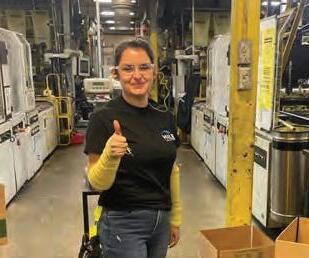
2 minute read
SAFETY CULTURE
SAFETY IS A CORE VALUE that is ingrained in everything we do from the way we operate our facilities to the way we design our products. Our safety culture is designed to ensure the well-being of our employees, contractors, customers, and communities. We have established teams and invested in processes to reduce risk and the potential for incidents to occur. More than 120 Novolex family members lead our health and safety programs, working alongside coworkers committed to achieving best-in-class environmental management programs, product quality initiatives, and food safety compliance. They work together to build a safety culture that is focused on constantly learning and communicating.
Communicating About Safety
Workers are encouraged to report work-related hazards during standing plant safety committee meetings, anonymously through suggestion boxes, and by using the Novolex Ethics Hotline. Safety committee meetings are conducted monthly and include both members of management and hourly employees. We empower employees to speak freely and give them a voice for change with our open-door policy without fear of reprisal to communicate safety matters one-on-one between workers and their supervisors. Employees are also able to report work-related hazards at safety committee meetings and receive periodic safety training, toolbox talks, assessments, and other communications to ensure a safe workplace.
Safety Programs and Initiatives
In 2022, a company-wide safety perception survey identified opportunities to further enhance our safety programs. In addition to activities at the plant level to address opportunities identified through the survey, Novolex has developed a steering team with members across divisions to drive company-wide initiatives to continue building a stronger safety culture. Among the changes was a decision to embrace the principles of Human Performance (HP) as a new way for Novolex to approach safety, and since then have started to apply the principles in other areas as well. HP is a holistic approach that includes understanding the way people, culture, equipment, processes, and systems interact, and how to put defenses in place to prevent incidents and injuries, reduce risk, and strengthen safety culture.
Novolex family members from every plant participated in various types of HP training, adding up to more than 7,500 hours of HP training across the organization in 2022.
“GOOD CATCH” PROGRAM
One outcome of our HP program was the launch in 2023 of the "Good Catch" program, which encourages employees to share near misses, suggest areas for improvement, and nominate colleagues for recognition when they observe fellow employees going the extra mile to make work safe and coach others.

Resources To Reduce Risk
At the heart of all Safety Programs is the reduction and elimination of risk, as well as providing the tools, training, and resources for employees to do their jobs safely. In addition to the HP training, employees participate in safety training through our Learning Management System, the use of “toolbox talks,” shift safety meetings, onboarding training for new hires, refresher courses, and other site-specific training. We also invested in front-line leadership training at 28 facilities, which included small group sessions, floor activities, and coaching for the participants about how to look at everyday activities through the lens of safety, risk identification, and risk mitigation. As well, plant leadership, along with the support of the workers on the floor, conduct GEMBA walks, audits, periodic risk assessments, and other means to identify and correct hazards in our production and shipping facilities.
Principles Of Human Performance
1 People are imperfect, and even the best make mistakes.
2 Error‐likely situations are predictable.
3 Individual behaviors are influenced by culture and leadership.
4 Organizations and people drift.
5 Events can be avoided by learning; how you respond to failure matters.
6 People achieve high levels of performance based on encouragement and reinforcement; blame fixes nothing.







